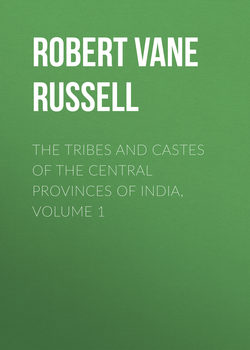Читать книгу The Tribes and Castes of the Central Provinces of India, Volume 1 - Robert Vane Russell - Страница 31
Part I.
Introductory Essay on Caste
Introductory Essay on Caste
28. The village priests. The gardening castes
ОглавлениеThe village priests are another class of this group. The regular village priest and astrologer, the Joshi or Parsai, is a Brāhman, but the occupation has developed a separate caste. The Joshi officiates at weddings in the village, selects auspicious names for children according to the constellations under which they were born, and points out the auspicious moment or mahūrat for weddings, name-giving and other ceremonies, and for the commencement of such agricultural operations as sowing, reaping, and threshing. He is also sometimes in charge of the village temple. He is supported by contributions of grain from the villagers and often has a plot of land rent-free from the proprietor. The social position of the Joshis is not very good, and, though Brāhmans, they are considered to rank somewhat below the cultivating castes. The Gurao is another village priest, whose fortune has been quite different. The caste acted as priests of the temples of Siva and were also musicians and supplied leaf-plates. They were village menials of the Marātha villages. But owing to the sanctity of their calling, and the fact that they have become literate and taken service under Government, the Guraos now rank above the cultivators and are called Shaiva Brāhmans. The Gondhalis are the village priests of Devi, the earth-goddess, who is also frequently the tutelary goddess of the village. They play the kettle-drum and perform dances in her honour, and were formerly classed as one of the village menials of Marātha villages, though they now work for hire. The Gārpagāri, or hail-averter, is a regular village menial, his duty being to avert hail-storms from the crops, like the χαλαζοφύλαξ in ancient Greece. The Gārpagāris will accept cooked food from Kunbis and celebrate their weddings with those of the Kunbis. The Jogis, Mānbhaos, Sātanis, and others, are wandering religious mendicants, who act as priests and spiritual preceptors to the lower classes of Hindus.
Group of religious mendicants
With the village priests may be mentioned the Māli or gardener. The Mālis now grow vegetables with irrigation or ordinary crops, but this was not apparently their original vocation. The name is derived from māla, a garland, and it would appear that the Māli was first employed to grow flowers for the garlands with which the gods and also their worshippers were adorned at religious ceremonies. Flowers were held sacred and were an essential adjunct to worship in India as in Greece and Rome. The sacred flowers of India are the lotus, the marigold and the champak63 and from their use in religious worship is derived the custom of adorning the guests with garlands at all social functions, just as in Rome and Greece they wore crowns on their heads. It seems not unlikely that this was the purpose for which cultivated flowers were first grown, at any rate in India. The Māli was thus a kind of assistant in the religious life of the village, and he is still sometimes placed in charge of the village shrines and is employed as temple-servant in Jain temples. He would therefore have been supported by contributions from the cultivators like the other village menials and have ranked below them, though on account of the purity and sanctity of his occupation Brāhmans would take water from him. The Māli has now become an ordinary cultivator, but his status is still noticeably below that of the good cultivating castes and this seems to be the explanation. With the Māli may be classed the Barai, the grower and seller of the pān or betel-vine leaf. This leaf, growing on a kind of creeper, like the vine, in irrigated gardens roofed with thatch for protection from the sun, is very highly prized by the Hindus. It is offered with areca-nut, cloves, cardamom and lime rolled up in a quid to the guests at all social functions. It is endowed by them with great virtues, being supposed to prevent heartburn, indigestion, and other stomachic and intestinal disorders, and to preserve the teeth, while taken with musk, saffron and almonds, the betel-leaf is held to be a strong aphrodisiac. The juice of the leaf stains the teeth and mouth red, and the effect, though repulsive to Europeans, is an indispensable adjunct to a woman’s beauty in Hindu eyes. This staining of the mouth red with betel-leaf is also said to distinguish a man from a dog. The idea that betel preserves the teeth seems to be unfounded. The teeth of Hindus appear to be far less liable to decay than those of Europeans, but this is thought to be because they generally restrict themselves to a vegetable diet and always rinse out their mouths with water after taking food. The betel-leaf is considered sacred; a silver ornament is made in its shape and it is often invoked in spells and magic. The original vine is held to have grown from a finger-joint of Bāsuki, the Queen of the Serpents, and the cobra is worshipped as the tutelary deity of the pān-garden, which this snake is accustomed to frequent, attracted by the moist coolness and darkness. The position of the Barai is the same as that of the Māli; his is really a low caste, sometimes coupled with the contemned Telis or oil-pressers, but he is considered ceremonially pure because the betel-leaf, offered to gods and eaten by Brāhmans and all Hindus, is taken from him. The Barai or Tamboli was formerly a village menial in the Marātha villages.
63
Michelia champaka, a variety of the jack or bread-fruit tree.
